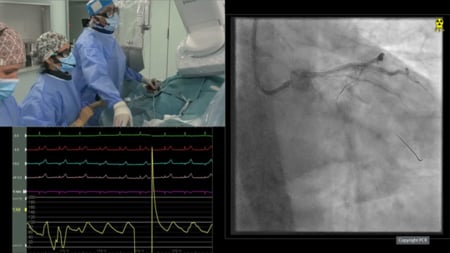2-Year outcomes after stenting of lipid-rich and nonrich coronary plaques (the COLOR Registry)
Selected in JACC by N. Ryan
The authors aimed to investigate the association between NIRS findings in culprit lesions and the clinical outcomes of those lesions in patients undergoing PCI for stable symptoms.
References
Authors
Yamamoto MH, Maehara A, Stone GW, Kini AS, Brilakis ES, Rizik DG, Shunk K, Powers ER, Tobis JM, Maini BS, Dixon SR, Goldstein JA, Petersen JL 2nd, Généreux P, Shah PR, Crowley A, Nicholls SJ, Mintz GS, Muller JE, Weisz G.
Reference
JACC 2020 Mar 31;75(12):1371-1382
Published
March 2020
Link
Read the abstractReviewer
My Comment
Why this study? – the rationale/objective
COLOR (Chemometric Observations of Lipid Core Plaques of Interest in Native Coronary Arteries Registry) was a prospective multicentre registry investigating the association between near-infrared spectroscopy (NIRS) findings in culprit lesions and the clinical outcomes of those lesions in patients with CAD undergoing PCI.
There has been significant focus on the concept of the ‘vulnerable’ plaque with initial studies suggesting that approximately two-thirds of all ACS were due to rupture of lipid-rich plaques (LRP). Pathological studies have highlighted potential links between stenting LRP and increased late adverse outcomes due to impaired healing. The authors aimed to investigate the association between NIRS findings in culprit lesions and the clinical outcomes of those lesions in patients undergoing PCI for stable symptoms.
How was it executed? – the methodology
COLOR was a prospective multicentre registry enrolling patients with a clinical indication for angiography and at least one NIRS obtained from a native coronary artery.
- The primary endpoint was a composite of MACE including cardiac death, MI, definite or probable stent thrombosis, unplanned revascularisation for progressive or unstable angina and unplanned hospitalisation for progressive or unstable angina.
- Events were divided into culprit lesion-related, non-culprit lesion-related or indeterminate.
- Following NIRS analysis the plaques were classified as 1) LRP with superficial attenuation, 2) LRP without superficial attenuation, 3) LRP with superficial calcification, 4) calcified non-LRP, 5) no LRP.
What is the main result?
COLOR included 1,999 patients from February 2009-February 2014, of those 1,189 patients (1283 lesions) had pre-PCI NIRS in the culprit lesion and these form the study population. Median follow up was 732 days (IQR 714-748).
- At 2 years follow up MACE had occurred in 18% of patients who underwent PCI, 8.3% culprit lesion-related, 10.7% non-culprit and 3.1% indeterminate. MACE was mainly driven by unplanned revascularisation.
- In culprit lesions, true bifurcation lesions (18.1% events vs. 9.1% no events p=0.0009), lesions treated for instant restenosis (25.7% events vs. 14.4% no events, p=0.002) and longer stent segments (37.0±25.6mm events vs. 20.5±18.5mm no events, p=0.001) were associated with increased MACE.
- The baseline lipid core burden index (LCBI) was not associated with increased MACE nor were there any association between NIRS LRP measurement and the individual components of MACE using multivariable Cox proportional hazard models.
Critical reading and the relevance for clinical practice
The results of this study show that there is no association between culprit lesion plaque characteristics, specifically the presence of LRP and clinical events related to these culprit lesions at two years in patients undergoing PCI. Culprit lesion MACE events were related to lesion complexity and mainly driven by unplanned revascularisation.
A note of caution when interpreting the results, one must bear in mind that although large numbers were included, this was registry study with operators not blinded to NIRS results which may have influenced their therapeutic strategy.
As shown in previous studies, using various forms of intracoronary imaging, despite the ability to identify potentially vulnerable plaques has yet to translate into a clinically relevant utility. This is likely due to the fact that atherosclerosis is a systemic disease effecting the entire coronary tree and not merely a specific site and acute coronary syndromes occur due to a milieu of events not just rupture of a vulnerable plaque. This data adds to the evidence that risk profiling patients should be focused on all cardiovascular risk factors not just an individual coronary lesion.





No comments yet!